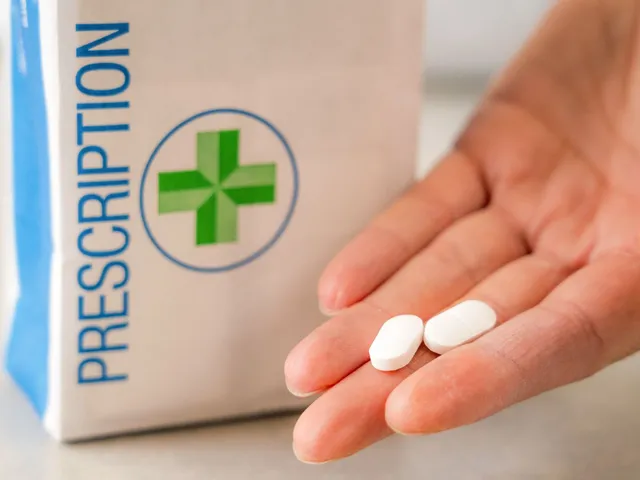Allergies don’t play fair. Just when you think you’ve found a pill that handles the sneezing, you wake up groggy, itchy, or with a dry mouth. Fexofenadine is a go-to for a lot of folks, but sometimes it causes trouble or just doesn’t seem to work. The good news? There are plenty of other options on the shelf, and each one has its own pros and cons.
So why bother looking beyond Fexofenadine? Sometimes it’s about cutting down on daytime drowsiness, avoiding weird side effects, or finding something stronger for unstoppable postnasal drip. Maybe you’re looking for a nasal spray instead of a pill, or you want something safe for your kid or during pregnancy.
We’ll take a look at 7 main alternatives, from simple tablets to sprays you use right in your nose. I’ll break down why you might pick one over the other, what to expect with each—like which ones pack an extra punch for stubborn stuffiness, and which ones will have you reaching for a pillow an hour later. This way, you don’t waste money (or time) on something that doesn’t fit your life.
- Loratadine (Claritin)
- Cetirizine (Zyrtec)
- Levocetirizine (Xyzal)
- Desloratadine (Clarinex)
- Diphenhydramine (Benadryl)
- Chlorpheniramine
- Fluticasone (Flonase)
- Which Allergy Med is Right for You?
Loratadine (Claritin)
When people talk about alternatives to Fexofenadine, Loratadine—usually sold as Claritin—always pops up. It’s a non-drowsy allergy medication you can grab right off the shelf, with no prescription needed. Loratadine blocks histamine, that troublemaker chemical that sparks sneezing, itching, and runny nose.
Most folks love that Loratadine rarely causes sleepiness. That’s a huge plus if you need to drive, work, or focus at school. It’s generally taken once a day, and you’ll usually start feeling better within an hour, although for some it might take a bit longer to really kick in. It covers classic hay fever symptoms: sneezing, itchy or watery eyes, and an itchy nose or throat. But if nasal congestion is your biggest issue, Loratadine may not do much on its own—you might need to pair it with a decongestant.
Pros
- Non-drowsy for most people, so you can go about your day.
- Long-lasting (24 hours), just one pill daily.
- Easy to find, and often pretty cheap as a generic.
- Safe for most ages (kids as young as two, in liquid or chewable form).
Cons
- Not super helpful if you’re mainly stuffed up (won’t clear nasal congestion).
- For some, it’s just not as strong as Cetirizine or Fexofenadine alternatives.
- Rarely, it can trigger headaches or dry mouth.
Here’s a quick breakdown showing how Loratadine stacks up compared to Fexofenadine on some key points:
| Drug | Drowsiness Risk | Onset | Lasts For | Main Uses |
|---|---|---|---|---|
| Loratadine | Low | 1–3 hours | 24 hours | Allergic rhinitis, itchy eyes/nose |
| Fexofenadine | Very low | 1 hour | 24 hours | Allergic rhinitis, hives |
If you want a non-drowsy pill for basic allergy symptoms and don’t have major congestion, Loratadine is an easy, safe choice. Folks with high blood pressure or those who need something for long-term daily use can relax—Loratadine usually checks those boxes too.
Cetirizine (Zyrtec)
Cetirizine, sold under the name Zyrtec, is one of those Fexofenadine alternatives you’ve probably seen advertised everywhere. This allergy medication is a second-generation antihistamine just like Fexofenadine, which means it’s less likely to make you feel super sleepy compared to the old-school stuff. But here’s the real talk: Zyrtec can still knock some people out, especially if you’re sensitive or take it at night.
Most adults take 10 mg once per day for seasonal and indoor allergies (think: dust, pet dander, pollen, and mold). It comes as tablets, chewables, or syrup—handy for kids who can’t swallow pills. Cetirizine kicks in fast, usually within the hour. This makes it a common choice if you’re looking for quick allergy relief and don’t want to wait half a day for a pill to kick in.
Cetirizine taken at the recommended dose is fast-acting and typically non-sedating, but a small percentage of users may still notice drowsiness, reports the American Academy of Allergy, Asthma & Immunology.
Zyrtec works all day but can cause drowsiness in about 10-14% of people, usually more than Fexofenadine but less than old-school meds like Benadryl. Want the numbers? In one study, only about 1 in 10 adults reported feeling noticeably tired on the regular dose.
| Feature | Cetirizine (Zyrtec) |
|---|---|
| Onset of Action | Within 1 hour |
| Main Side Effect | Drowsiness (in 10-14% of adults) |
| Duration | 24 hours |
| Forms | Tablet, chewable, syrup |
People like Cetirizine for its reliability. You don’t need to worry about meal timing, and it isn’t known to interact with a ton of other meds. Both adults and kids over 2 can use it, which is a plus for parents who want one bottle for the whole family. Just keep an eye out for possible dry mouth or headaches, which aren’t super common but still possible.
Pros
- Kicks in fast—usually within an hour
- One tablet usually covers you for the whole day
- Works for most seasonal and indoor allergies
- Comes in kid-friendly chewables and syrup
- Minimal interaction with most other medications
Cons
- Can cause drowsiness, especially if you’re sensitive
- May cause some dry mouth or headaches
- Less effective for nasal congestion compared to some nasal sprays
Bottom line: Cetirizine (Zyrtec) is a solid pick when Fexofenadine alternatives are needed, especially if you want fast action and don’t mind a small chance of nap attacks.
Levocetirizine (Xyzal)
If you’ve tried Fexofenadine alternatives and nothing seems to touch your allergies, Levocetirizine (known by the brand name Xyzal) might be the next thing to check out. It’s a newer antihistamine, often called a "third-generation" option. A lot of allergy specialists reach for Levocetirizine when the classics aren’t enough.
So, how does it compare? Levocetirizine is the “active” version of Cetirizine (Zyrtec), which means your body doesn’t have to do that extra processing step. Some folks say it kicks in faster—usually within an hour—and lasts a solid 24 hours per dose. That’s handy for people who want to avoid the late-day allergy misery without having to remember a second pill.
This one is especially good if you deal with year-round symptoms, like allergies to dust, pets, or mold. The tablets are tiny and easy to swallow. Plus, if you need something for a kid, Xyzal comes in a syrup for children as young as 6 months. Most people say it causes less drowsiness than older drugs, but every body reacts a bit differently—so it’s worth trying once at bedtime to see how you feel.
Here’s how the pros and cons stack up:
Pros
- Works fast—relief can start in about an hour
- Lasts 24 hours, so only one dose a day
- Can be less sedating than older antihistamines
- Suitable for young kids (down to 6 months old)
- Good for both seasonal and indoor allergies
Cons
- Might still cause drowsiness for some people (use caution with driving)
- Not the best for itchy skin conditions (sometimes other meds are preferred)
- Cost can be higher than generics like Cetirizine
- Potential for dry mouth and headache
According to recent pharmacy data, Levocetirizine is one of the top choices for allergy relief in Europe, but in the US, more folks tend to start with Zyrtec and only move to Xyzal if they need a bit more oomph or fewer side effects.
If you’re struggling to find the right allergy medication, Levocetirizine is definitely one to ask your doctor about—especially if daytime sleepiness has been a headache with other allergy pills.
Desloratadine (Clarinex)
If you’ve tried Fexofenadine alternatives before and still haven’t found your match, Desloratadine—better known as Clarinex—might be worth a shot. It’s actually the active form of loratadine (Claritin), so it tends to kick in a bit faster for some people. Desloratadine is a prescription-only allergy medication, which means you’ll need your doctor’s okay before you can pick it up at the pharmacy.
Clarinex is a favorite for folks battling hay fever and year-round sniffles. It blocks histamine, just like other non-drowsy antihistamines, but it’s designed to stay working for a full 24 hours. This makes it convenient if you’re tired of remembering daytime and nighttime doses. And compared to older antihistamines like diphenhydramine, it barely causes any drowsiness, so you won’t feel sluggish at work or school.
For parents, there are chewable tablets and syrup options for kids as young as six months, which is handy if the little ones are always sneezing their heads off around pollen season.
Pros
- 24-hour relief, just one pill a day—no multiple doses to juggle
- Little to no drowsiness for most people, so it doesn’t mess with your routine
- Effective against both indoor and outdoor allergies (think dust mites or ragweed)
- Available in syrup and chewable forms for kids (from 6 months old up)
- Less likely to interact with other medicines compared to some other antihistamines
Cons
- Prescription required—can’t just grab it off the shelf
- Some insurance plans put it in a higher copay tier, so it may cost a little more
- Rare side effects like sore throat, dry mouth, or muscle pain show up for a few people
- Very rarely, it can cause headaches or upset stomach (usually mild)
Here’s a quick breakdown of how Desloratadine stacks up in key areas:
| Feature | Desloratadine |
|---|---|
| Dosing | Once daily |
| Prescription | Yes |
| Drowsiness risk | Low |
| Forms available | Tablet, syrup, chewable tablet |
| Minimum age | 6 months |
If you want steady, reliable allergy relief and are fine with calling your doctor, Desloratadine packs a punch without making you feel like a zombie.

Diphenhydramine (Benadryl)
Here’s an old-school allergy medication that’s been on pharmacy shelves for ages—Diphenhydramine, best known as Benadryl. It’s one of the first antihistamines lots of people ever try, especially for those sudden allergy flare-ups or when you’re desperate for sleep because of itchy eyes and sneezing. It works fast, usually within an hour, making it a go-to for allergy relief when you can’t wait.
Benadryl isn’t just for allergies; it’s also used for things like motion sickness, hives, and sometimes even mild cases of insomnia. The active ingredient blocks histamine, which is what sets off most typical allergic reactions. But let’s be real—this med is famous for knocking people out. Drowsiness shows up in almost everybody, so it’s not great if you need a clear head during the day.
Pros
- Reliable, fast-acting allergy relief—great for sudden symptoms or nighttime use
- Available everywhere without a prescription
- Works well for different allergy symptoms (sneezing, runny nose, itchy skin, hives)
- Can double up as sleep aid when allergies disrupt rest
- Comes in tablets, liquid, and even topical creams
Cons
- Very likely to cause drowsiness—don’t take before driving or work
- Short-acting, so you might need repeated doses for all-day relief
- Can cause dry mouth, constipation, and blurred vision
- Long-term use isn’t recommended (especially for older adults—linked to memory issues)
- Not the best for kids unless your doctor says it’s okay
Here’s a quick look at how Benadryl's drowsiness really stacks up compared to some other popular Fexofenadine alternatives:
| Antihistamine | Common Drowsiness |
|---|---|
| Diphenhydramine (Benadryl) | Very High |
| Loratadine (Claritin) | Low |
| Cetirizine (Zyrtec) | Moderate |
| Fexofenadine (Allegra) | Low |
Because Benadryl is strong on drowsiness and dries everything out, most people lean on it for bedtime or severe, short-term allergy attacks. If you’re just trying to get through spring with your brain still working, it probably isn’t the best daily option. But for serious itching or middle-of-the-night allergy misery, it gets the job done.
Chlorpheniramine
Chlorpheniramine is one of the classic antihistamines that’s been around for a really long time—think decades, not years. It works by blocking histamine, the annoying chemical your body releases when it’s triggered by things like pollen, dust, or animal dander. So when you pop a chlorpheniramine tablet, most people notice a quick drop in sneezing, runny nose, and itchy eyes.
Unlike newer allergy drugs like Fexofenadine or Loratadine (Claritin), chlorpheniramine is considered a "first-generation antihistamine." This sounds fancy, but all it means is it crosses into your brain way more than the newer meds do. That gives it some extra kick against allergy symptoms but also means there’s a bigger risk for drowsiness or feeling out of it. It’s actually what people took for allergies before the non-drowsy versions hit the market.
Pros
- Fast-acting—you’ll usually start feeling relief in under an hour.
- Available over-the-counter (OTC) and cheap (sometimes you’ll see it in combo cold and allergy meds, too).
- Works for a big mix of allergens: pet dander, pollen, dust, even some food allergies in a pinch.
- Can help with both allergy symptoms and some cold issues, like a runny nose.
Cons
- Makes lots of people sleepy or sluggish—don’t take it before driving or working machinery.
- Short duration: you might need to take it every 4–6 hours to keep symptoms away.
- Can dry you out—think dry mouth, trouble peeing (especially if you have prostate issues), or constipation.
- Should be avoided in young kids or older adults (it can cause confusion or increase risk of falls).
- Sometimes interacts with other meds, especially ones that also make you drowsy.
Here’s a really basic comparison so you can see when chlorpheniramine might come in handy versus newer options:
| Medication | Drowsiness | How Fast It Works | How Often to Take |
|---|---|---|---|
| Chlorpheniramine | Common | Within 1 hour | Every 4-6 hrs |
| Fexofenadine | Rare | Within 1 hour | Once or twice a day |
If you need allergy relief fast and you don’t mind the risk of drowsiness (or you actually want help falling asleep at night), chlorpheniramine is a solid backup. But for daily long-term allergy control, there are usually better-tolerated choices out there.
Fluticasone (Flonase)
If you’re tired of popping pills and your main trouble is stuffy nose or postnasal drip, Fluticasone—or Flonase—might be worth a shot. This isn’t an allergy pill you swallow. It’s a nasal spray, and it works right where the allergies start.
Flonase is a topical corticosteroid that cuts down inflammation inside your nose. It’s approved for both adults and kids (usually older than 4), and is one of the most popular over-the-counter treatments for chronic allergic rhinitis. The best part? There’s barely any absorption into the rest of your body, so you avoid many of the common side effects from regular allergy pills.
Pros
- Super effective for stubborn nasal symptoms: congestion, runny nose, sneezing, itching, and even those annoying drips in your throat.
- Doesn’t tend to make you sleepy or jittery, which happens with some allergy medication.
- Safe enough for long-term use in most cases if your doctor says it’s okay.
- Minimal absorption—means fewer body-wide side effects compared to pills.
- One bottle usually lasts about a month, so it’s cost-effective if you have ongoing allergies.
Cons
- No instant relief—it can take a few days before you notice results. You’ve got to use it every day for best effect.
- Common side effects are local: stuff like mild nose irritation, dryness, or the occasional nosebleed.
- If you use it wrong (like spraying toward your septum), you might up your risk of bleeding or soreness.
- It doesn’t really help with itching or allergy symptoms outside your nose, like itchy eyes or hives.
People often have questions about how quickly Flonase works or if it’s safe to use long term. According to a major 2023 review of nasal corticosteroids, most users reported full relief within 3 to 7 days, though some felt better in just 12 hours. Doctors generally like Flonase for people who have stuffy nose as their biggest problem and for those who want to dodge systemic side effects—something you just can’t do with most traditional antihistamines.
| Feature | Fluticasone (Flonase) |
|---|---|
| Type | Nasal spray corticosteroid |
| Best for | Chronic nasal allergy symptoms |
| Onset | 3-7 days |
| Drowsiness | No |
| Major cons | Local irritation, nosebleeds |
If other allergy meds leave you groggy or just don’t touch your nasal congestion, Flonase can be a game changer. Just remember to use it as directed—point away from your septum and stick with it for a week before you judge if it’s working.
Which Allergy Med is Right for You?
Picking the right allergy medication can feel like trial-and-error, especially when every box claims it’s “non-drowsy” or “fast-acting.” Here’s what you actually need to think about before grabbing your next allergy fix. Each of the Fexofenadine alternatives works a bit differently, and your own symptoms, age, routine, or other health conditions matter a lot.
Here’s a quick-and-easy way to narrow your choices:
- For non-drowsy, daily relief: Loratadine (Claritin) and Desloratadine (Clarinex) are top picks. They rarely cause sleepiness and are simple to take once a day.
- For fast, tough symptom relief: Cetirizine (Zyrtec) and Levocetirizine (Xyzal) might feel stronger, but they can make you drowsy, especially at higher doses or if you’re sensitive.
- Super stubborn congestion? Fluticasone (Flonase) as a nasal spray tackles swelling and stuffiness right at the source. It takes a couple days to kick in, but it works well for ongoing congestion and postnasal drip.
- Nighttime flare-ups: First-generation meds like Diphenhydramine (Benadryl) or Chlorpheniramine will knock out allergies—and probably knock you out, too. They're better reserved for overnight use or emergencies, not daily snooze-fests.
- Kiddos, pregnancy, or other health quirks? Always check label ages and double-check with your doctor or pharmacist. Not all meds are safe for young children or pregnant folks.
Here’s a comparison table to help you see the differences side-by-side:
| Medication | Form | Drowsiness | Best For | How Fast? |
|---|---|---|---|---|
| Fexofenadine | Tablet | Rare | General allergies | 1-3 hours |
| Loratadine | Tablet, syrup | Rare | Mild-moderate allergies | 1-3 hours |
| Cetirizine | Tablet, syrup | Sometimes | Stronger symptom relief | Within 1 hour |
| Levocetirizine | Tablet | Sometimes | Severe allergies | 30-60 minutes |
| Desloratadine | Tablet, syrup | Rare | Year-round use | 1-3 hours |
| Diphenhydramine | Tablet, liquid | Common | Emergency relief, sleep | 15-30 minutes |
| Chlorpheniramine | Tablet | Common | Short-term use | 30 minutes |
| Fluticasone | Nasal spray | No | Chronic congestion | Days for full effect |
No single allergy medication is perfect for everyone, so it’s worth talking to a pharmacist or your doctor if you’ve struck out with a few already. Keep track of what works and what leaves you feeling blah. Most people eventually find a match—it just takes a little honest trial and attention to your own body.






Adam O'Rourke
July 18, 2025 AT 14:37Oh, great, another listicle about allergy meds. Because that’s exactly what we needed, right?
Honestly, if Fexofenadine isn’t cutting it, maybe the problem isn’t the drug but the fact that your body’s just being extra. 🙄 But sure, it’s always fun to see what else Big Pharma has up their sleeves.
The article’s cool though, I guess. Breaks down the seven options like it’s some sort of epic saga. Like, nasal sprays versus oral antihistamines, the dusty drama continues.
Still, I’m wondering if anyone here has actually switched away and felt a legit difference? Or is it just placebo-ville for most?
Whatever, I’ll stick to my sarcastic pills for now. Anyone else feeling me on this?
Mary-Pat Quilty
July 21, 2025 AT 20:46Adam, your sarcasm is noted, darling, but oh the poetic tragedy of allergic suffering! It is not a mere battle against pollen but a veritable saga of the sinus and spirit entwined.
When Fexofenadine fails, it is as if the symphony of relief falls silent and we are cast into the dissonance of endless sneezes and itchy eyes, a cruel comedy by nature’s hand.
I do applaud the article’s gritty, practical essence, despite its clinical face; it wraps all these medicinal tales in a humble cloak of hope. To find the elixir that sings to your unique biology - a dance choreographed by the stars themselves!
Does anyone recall the silence a true match brings? That sweet moment when allergies retreat like a fading lament… ah, to dream.
Patrick McGonigle
July 23, 2025 AT 20:00Thank you both for sharing such colorful perspectives.
Practically speaking, the choice of allergy medication often boils down to individual response and tolerance. Fexofenadine, while effective for many, can produce unwanted side effects or insufficient relief in others.
The article in question offers a useful overview of alternatives that should be considered under the guidance of a healthcare professional.
For example, nasal sprays may provide targeted relief for nasal symptoms, but they require consistent application and may not be suitable for everyone.
I encourage those struggling with allergies to consult their physicians to tailor a treatment that best fits their needs, considering both efficacy and safety.
Rex Wang
July 26, 2025 AT 21:36Interesting write-up! Allergies can be so unpredictable, right? Sometimes meds that work wonders for one don’t help at all for someone else.
This breakdown really helps map out some options when you feel stuck with Fexofenadine.
I personally had success switching to a different oral antihistamine, and the difference was noticeable—less drowsiness, too.
The real-life tips are gold, since navigating all these options can be confusing without a guide.
Has anyone here tried nasal sprays as a solo treatment? Curious how effective they are compared to pills.
mark Lapardin
July 30, 2025 AT 13:06This article approaches the topic with admirable clarity, distilling the complex pharmacodynamics of allergy medications into digestible insights.
Fexofenadine, a second-generation antihistamine, differs pharmacokinetically from others by virtue of its non-sedative profile, but alternatives exist that might better interface with an individual’s histamine receptor activity.
It would be beneficial if the piece included detailed mechanisms of action for each alternative, as this informs prescribers and users about the rationale behind therapeutic choices.
Still, as a primer, this is effective.
Barry Singleton
August 1, 2025 AT 06:46While the article is informative, my skepticism about the broad push for ever-changing allergy meds remains.
There's a certain overreliance on chemical intervention that obscures underlying environmental or lifestyle adjustments.
Even more so, the pharmaceutical marketing machine thrives on presenting every slight inefficiency as a call for a new product.
That said, I appreciate the candid discussion about side effects, which is frequently glossed over.
Javier Garcia
August 2, 2025 AT 10:33Good article for those curious about the choices beyond Fexofenadine.
But I’m wondering, does anyone know how these alternatives fare in terms of long-term use? Are there safety concerns we should be aware of?
Also, what about cost differences? Some allergy meds can really empty the wallet fast.
Would love some personal experiences here to balance the clinical info.
Donnella Creppel
August 4, 2025 AT 12:33Honestly, this article is like allergy medicine 101 written by someone who’s never actually suffered a season’s true wrath.
Sure, the list is 'helpful' if you're allergic to bland summaries, but where’s the existential part? The fight for breath, the betrayal of your own body!
They throw in tips and side effects like garnish on a colorless plate — no soul, no blood, no mess.
Also, why so shy about addressing probable interactions? Like, sprinkle a dash of reality that these meds don’t operate in a vacuum.
All in all, a missed chance to enlighten the weary warrior against histamine’s tyranny.
Jarod Wooden
August 7, 2025 AT 23:53This discussion reeks of the unnecessary repudiation of a foundational pharmaceutical staple.
The pharmacological robustness of Fexofenadine cannot be so easily dismissed in favor of alternatives less proven in clinical efficacy.
Thus, promoting a plurality of options without critical hierarchical analysis muddies the water.
One must interrogate the epistemological underpinnings of such diversification—is it patient-centered or commodification under the guise of choice?
I urge this community to consider the deeper abstractions before embracing alternatives blindly.
lee charlie
August 12, 2025 AT 15:00Hey all, thanks for the insightful points being raised here.
Personally, I think it’s just really important we encourage folks to find what works best individually without getting too caught up in the debate over which drug is the best on paper.
Sometimes a simpler option can still be effective, and side effects might matter more than some fancy-sounding pharmacology.
Doesn’t hurt to try alternatives cautiously, as long as you’re informed and in touch with your practitioner.
Hope everyone finds relief soon—spring allergies can be brutal.
Greg DiMedio
August 17, 2025 AT 14:37I appreciate the article but can’t help but feel it’s another one of those generic advice posts that fail to confront the real irritants — literally and figuratively.
We’re spoon-fed options but not the underlying guidance for proper diagnosis and cause mitigation.
Frankly, if you haven’t explored environmental controls alongside your meds, you’re just shuffling deck chairs on the Titanic.
Let’s also be honest, some of these ‘alternatives’ are just lesser-known players eager for market share, not necessarily better solutions.
Anyone else tired of the perpetual merry-go-round of allergy meds?